
Steamboats of the Columbia River
Encyclopedia

- This article concerns steamboats operating between Tri-Cities, Washington and the Pacific Ocean. For boats on the river's upper reaches, see Steamboats of Columbia River, Wenatchee ReachSteamboats of Columbia River, Wenatchee ReachSteamboats operated on the Wenatchee Reach of the Columbia River from the late 1880s to 1915. The main base of operations was Wenatchee, Washington, located at the confluence of the Wenatchee and Columbia Rivers, from the mouth of the river. Operations were mainly between Wenatchee and Bridgeport...
, Steamboats of the upper Columbia and Kootenay RiversSteamboats of the upper Columbia and Kootenay RiversFrom 1886 to 1920, steamboats ran on the upper reaches of the Columbia and Kootenay in the Rocky Mountain Trench, in western North America. The circumstances of the rivers in the area, and the construction of transcontinental railways across the trench from east to west made steamboat navigation...
, and Steamboats of the Arrow LakesSteamboats of the Arrow LakesThe era of steamboats on the Arrow Lakes and adjoining reaches of the Columbia River is long-gone but was an important part of the history of the West Kootenay and Columbia Country regions of British Columbia. The Arrow Lakes are formed by the Columbia River in southeastern British Columbia...
.
Many steamboat
Steamboat
A steamboat or steamship, sometimes called a steamer, is a ship in which the primary method of propulsion is steam power, typically driving propellers or paddlewheels...
s operated on the Columbia River
Columbia River
The Columbia River is the largest river in the Pacific Northwest region of North America. The river rises in the Rocky Mountains of British Columbia, Canada, flows northwest and then south into the U.S. state of Washington, then turns west to form most of the border between Washington and the state...
and its tributaries
Tributaries of the Columbia River
Tributaries and sub-tributaries are hierarchically listed in order from the mouth of the Columbia River upstream. Major dams and reservoir lakes are also noted.-Minor tributaries:* Skipanon River * Lewis and Clark River * Youngs River...
, in the Pacific Northwest
Pacific Northwest
The Pacific Northwest is a region in northwestern North America, bounded by the Pacific Ocean to the west and, loosely, by the Rocky Mountains on the east. Definitions of the region vary and there is no commonly agreed upon boundary, even among Pacific Northwesterners. A common concept of the...
region of North America
North America
North America is a continent wholly within the Northern Hemisphere and almost wholly within the Western Hemisphere. It is also considered a northern subcontinent of the Americas...
, from about 1850 to 1981. Major tributaries of the Columbia that formed steamboat routes included the Willamette
Willamette River
The Willamette River is a major tributary of the Columbia River, accounting for 12 to 15 percent of the Columbia's flow. The Willamette's main stem is long, lying entirely in northwestern Oregon in the United States...
and Snake
Snake River
The Snake is a major river of the greater Pacific Northwest in the United States. At long, it is the largest tributary of the Columbia River, the largest North American river that empties into the Pacific Ocean...
rivers. Navigation was impractical between the Snake River and the U.S./Canadian border, due to several rapids, but steamboats also operated along the Wenatchee Reach of the Columbia, in northern Washington, and on the Arrow Lakes
Steamboats of the Arrow Lakes
The era of steamboats on the Arrow Lakes and adjoining reaches of the Columbia River is long-gone but was an important part of the history of the West Kootenay and Columbia Country regions of British Columbia. The Arrow Lakes are formed by the Columbia River in southeastern British Columbia...
of southern British Columbia
British Columbia
British Columbia is the westernmost of Canada's provinces and is known for its natural beauty, as reflected in its Latin motto, Splendor sine occasu . Its name was chosen by Queen Victoria in 1858...
.
Types of craft
The paddle-wheelPaddle steamer
A paddle steamer is a steamship or riverboat, powered by a steam engine, using paddle wheels to propel it through the water. In antiquity, Paddle wheelers followed the development of poles, oars and sails, where the first uses were wheelers driven by animals or humans...
steamboat
Steamboat
A steamboat or steamship, sometimes called a steamer, is a ship in which the primary method of propulsion is steam power, typically driving propellers or paddlewheels...
has been described as an economic "invasion craft" which allowed the rapid exploitation of the Oregon Country
Oregon Country
The Oregon Country was a predominantly American term referring to a disputed ownership region of the Pacific Northwest of North America. The region was occupied by British and French Canadian fur traders from before 1810, and American settlers from the mid-1830s, with its coastal areas north from...
, a huge area of the North American continent eventually divided between the United States and Canada, and of Alaska and the Yukon. Three basic types of steamboat were used on inland waterways: propeller, side-wheeler, and sternwheeler. Propellers required deeper draft than was commonly available on inland rivers, and side-wheelers required expensive docking facilities. Stern-wheelers were more maneuverable than side-wheelers and could make a landing just about anywhere. For these reasons, the stern-wheeler type was dominant over the propeller and the side-wheeler in almost all inland water routes.
Economics of operations
Steamboats earned money by charging passengers fares and shippers for carrying cargo. Some vessels managed to carry as many as 500 people together with 500 tons of cargo. Passenger fares varied over time. In the early 1850s, fares for the Eagle, running from Oregon City and Portland, were $5 a trip for passengers and $15 per ton of freight. During a gold rush, passenger fares were $23 for passage from PortlandPortland, Oregon
Portland is a city located in the Pacific Northwest, near the confluence of the Willamette and Columbia rivers in the U.S. state of Oregon. As of the 2010 Census, it had a population of 583,776, making it the 29th most populous city in the United States...
to Wallula
Wallula Gap
Wallula Gap is a large water gap of the Columbia River through basalt anticlines in the Columbia River Basin in the U.S. state of Washington, just south of the confluence of the Walla Walla and Columbia rivers...
, with various other charges, such as meals, in addition. Cargo was charged by the ton and by the distance carried. Sample rates in the early 1860s, following the establishment of a near monopoly on river transit, showed cargo rates running from $15 per ton for the haul from Portland to The Dalles
The Dalles, Oregon
The Dalles is the largest city and county seat of Wasco County, Oregon, United States. The name of the city comes from the French word dalle The Dalles is the largest city and county seat of Wasco County, Oregon, United States. The name of the city comes from the French word dalle The Dalles is...
(121 miles (194.7 km)) , and 90 per ton for Portland to Lewiston
Lewiston, Idaho
Lewiston is a city in and also the county seat of Nez Perce County in the Pacific Northwest state of Idaho. It is the second-largest city in the northern Idaho region, behind Coeur d'Alene and ninth-largest in the state. Lewiston is the principal city of the Lewiston, ID - Clarkston, WA...
(501) miles. A ton was not a unit of weight but a unit of volume, with cargo charges based on 40 cubic feet equalling one ton. Various chicaneries were practiced by the steamboat companies to increase the tonnage charges for items shipped. One authority states that gross tonnage was measured at 100 cubic feet to the ton, which would still permit the steamboat companies to fix the "ton" for customer charges at 40 cubic feet.
Steamboat capacity was measured by tonnage
Tonnage
Tonnage is a measure of the size or cargo carrying capacity of a ship. The term derives from the taxation paid on tuns or casks of wine, and was later used in reference to the weight of a ship's cargo; however, in modern maritime usage, "tonnage" specifically refers to a calculation of the volume...
. Gross tonnage was the total volume capacity of the boat, while registered tonnage was the total theoretical volume that could be used to carry cargo or passengers once mechanical, fuel and similar areas had been deducted. For example, the sternwheeler Hassalo
Hassalo (sternwheeler 1880)
The steamboat Hassalo operated from 1880 to 1898 on the Columbia River and Puget Sound. Hassalo became famous for running the Cascades of the Columbia on May 26, 1888 at a speed approaching an hour...
, built in 1880, was 160 feet (48.8 m) long, and rated at 462 gross tons and 351 registered tons. Steamboat captains often became wealthy men. In 1858, the owners of the Colonel Wright
Colonel Wright (sternwheeler)
The Colonel Wright was the first steamboat to operate on the Columbia River above The Dalles in the parts of the Oregon Country that later became the U.S. states of Oregon, Washington and Idaho. She was the first steamboat to run on the Snake River. She was named after Colonel George Wright, an...
paid her captain, Leonard Wright, $500 per month, an enormous amount of money for the time.
Fuel and fuel consumption

Cord (unit of volume)
The cord is a unit of measure of dry volume used in Canada and the United States to measure firewood and pulpwood. A cord is the amount of wood that, when "ranked and well stowed" , occupies a volume of...
an hour. Areas without much wood, such as the Columbia River east of Hood River
Hood River, Oregon
The city of Hood River is the seat of Hood River County, Oregon, United States. It is a port on the Columbia River, and is named for the nearby Hood River. As of the 2000 census, the city population was 5,831...
, required wood to be hauled in and accumulated at wood lots along the river Provision of fuel wood for steamboats itself became an important economic activity.
Commodities shipped
Timmen reports that in 1867, Portland's exports totaled $6,463,793, of which about $4 million was gold dust and ingots mined from IdahoIdaho
Idaho is a state in the Rocky Mountain area of the United States. The state's largest city and capital is Boise. Residents are called "Idahoans". Idaho was admitted to the Union on July 3, 1890, as the 43rd state....
and Montana
Montana
Montana is a state in the Western United States. The western third of Montana contains numerous mountain ranges. Smaller, "island ranges" are found in the central third of the state, for a total of 77 named ranges of the Rocky Mountains. This geographical fact is reflected in the state's name,...
mines to be taken to the San Francisco mint
San Francisco Mint
The San Francisco Mint is a branch of the United States Mint, and was opened in 1854 to serve the gold mines of the California Gold Rush. It quickly outgrew its first building and moved into a new one in 1874. This building, the Old United States Mint, also known affectionately as The Granite Lady,...
. In 1870, the situation was similar. Other commodities hauled included lumber, agricultural products, salted salmon, and livestock. Once gold mines started winding down, the steamboats on the upper Columbia
Columbia River
The Columbia River is the largest river in the Pacific Northwest region of North America. The river rises in the Rocky Mountains of British Columbia, Canada, flows northwest and then south into the U.S. state of Washington, then turns west to form most of the border between Washington and the state...
and Snake
Snake River
The Snake is a major river of the greater Pacific Northwest in the United States. At long, it is the largest tributary of the Columbia River, the largest North American river that empties into the Pacific Ocean...
rivers carried wheat.
Lower, middle, and upper Columbia

Columbia River
The Columbia River is the largest river in the Pacific Northwest region of North America. The river rises in the Rocky Mountains of British Columbia, Canada, flows northwest and then south into the U.S. state of Washington, then turns west to form most of the border between Washington and the state...
from Wallula to its mouth as the lower, middle and upper river, generally defined as:
- The "lower river," meaning the routes from AstoriaAstoria, OregonAstoria is the county seat of Clatsop County, Oregon, United States. Situated near the mouth of the Columbia River, the city was named after the American investor John Jacob Astor. His American Fur Company founded Fort Astoria at the site in 1811...
upriver to where the WillametteWillamette RiverThe Willamette River is a major tributary of the Columbia River, accounting for 12 to 15 percent of the Columbia's flow. The Willamette's main stem is long, lying entirely in northwestern Oregon in the United States...
flows into the Columbia, and then up the Willamette to Portland or Oregon CityOregon City, OregonOregon City was the first city in the United States west of the Rocky Mountains to be incorporated. It is the county seat of Clackamas County, Oregon...
. The lower river also included the run up the Columbia River GorgeColumbia River GorgeThe Columbia River Gorge is a canyon of the Columbia River in the Pacific Northwest of the United States. Up to deep, the canyon stretches for over as the river winds westward through the Cascade Range forming the boundary between the State of Washington to the north and Oregon to the south...
from the mouth of the Willamette to the portage (and, later, locks) at the Cascades RapidsCascades RapidsThe Cascades Rapids were an area of rapids along North America's Columbia River, between the U.S. states of Washington and Oregon. Through a stretch approximately wide, the river dropped about in .-Boat portage:Boat travelers were forced to either portage boats and supplies or pull boats up with...
. - The "middle river," meaning the route from the top of the Cascades to The Dalles, where another set of rapids began, called Celilo FallsCelilo FallsCelilo Falls was a tribal fishing area on the Columbia River, just east of the Cascade Mountains, on what is today the border between the U.S. states of Oregon and Washington...
, which required another and longer portage. - The "upper river" meaning the route from Celilo VillageCelilo Village, OregonCelilo Village, Oregon is an unincorporated Native American community on the Columbia River in northeastern Wasco County in the U.S. state of Oregon. It is near Lake Celilo, the former site of Celilo Falls; it is just south of the community of Wishram, Washington, across the Columbia River.In 2003...
, at the top of Celilo Falls, to Wallula Gap, near the mouth of the Snake River.
Willamette River
The Willamette River flows northwards down the Willamette ValleyWillamette Valley
The Willamette Valley is the most populated region in the state of Oregon of the United States. Located in the state's northwest, the region is surrounded by tall mountain ranges to the east, west and south and the valley's floor is broad, flat and fertile because of Ice Age conditions...
until it meets the Columbia River at a point 101 miles (162.5 km) from the mouth of the Columbia. In the natural condition of the river, Portland was the farthest point on the river where the water was deep enough to allow ocean-going ships. Rapids further upstream at Clackamas were a hazard to navigation, and all river traffic had to portage around Willamette Falls
Willamette Falls
The Willamette Falls is a natural waterfall on the Willamette River between Oregon City and West Linn, Oregon, in the United States. It is the largest waterfall in the Pacific Northwest and the eighteenth largest in the world by water volume. Horseshoe in shape, it is wide and high with a flow...
, where Oregon City had been established as the first major town inland from Astoria.
Snake River
The Snake River was navigable by steamboat from Wallula up to Lewiston, IdahoLewiston, Idaho
Lewiston is a city in and also the county seat of Nez Perce County in the Pacific Northwest state of Idaho. It is the second-largest city in the northern Idaho region, behind Coeur d'Alene and ninth-largest in the state. Lewiston is the principal city of the Lewiston, ID - Clarkston, WA...
. Boats on this run included Lewiston, Spokane, and J.M. Hannaford. Imnaha and Mountain Gem were able to proceed 55 miles (88.5 km) upriver from Lewiston, through the Snake River Canyon, to the Eureka Bar, to haul ore from a mine that had been established there.
Discontinuous inland routes on the Columbia
Far inland, the Columbia river was interrupted by rapids and falls, so much that it was never made freely navigable once Priest RapidsPriest Rapids
Priest Rapids was a narrow, fast-flowing stretch of the Columbia River, located in the central region of the U.S. state of Washington. It was flooded by the construction of the Priest Rapids Dam in the 1950s....
was reached above Pasco, Washington
Pasco, Washington
Pasco is a city in and the county seat of Franklin County, Washington, United States.Pasco is one of three cities that make up the Tri-Cities region of the state of Washington...
. There were important steamboat operations on many lakes that ultimately were tributary to the Columbia River, both in the United States and in Canada. These routes included Okanagan Lake
Okanagan Lake
Okanagan Lake is a large, deep lake in the Okanagan Valley of British Columbia. The lake is 135 km long, between 4 and 5 km wide, and has a surface area of 351 km². The lake's maximum depth is 232 meters near Grant Island...
, Arrow Lakes
Arrow Lakes
The Arrow Lakes in British Columbia, Canada, divided into Upper Arrow Lake and Lower Arrow Lake, are widenings of the Columbia River. The lakes are situated between the Selkirk Mountains to the east and the Monashee Mountains to the west. Beachland is fairly rare, and is interspersed with rocky...
, Kootenay Lake
Kootenay Lake
Kootenay Lake is a lake located in British Columbia, Canada and is part of theKootenay River. The lake has been raised by the Corra Linn Dam and has a dike system at the southern end, which, along with industry in the 1950s-70s, has changed the ecosystem in and around the water...
and Kootenay River
Kootenay River
The Kootenay is a major river in southeastern British Columbia, Canada and the northern part of the U.S. states of Montana and Idaho. It is one of the uppermost major tributaries of the Columbia River, which is the largest North American river that empties into the Pacific Ocean...
, and lakes Coeur d'Alene
Lake Coeur d'Alene
Lake Coeur d'Alene is a natural lake in the Idaho Panhandle, located in the vicinity of the city of the same name. It spans long, ranges from 1 to wide and has over of shoreline for boaters and vacationers to explore and enjoy.-Geology and geography:...
and Pend Oreille
Lake Pend Oreille
Lake Pend Oreille is a lake in the northern Idaho Panhandle, with a surface area of . It is 65 miles long, and 1,150 feet deep in some regions, making it the fifth deepest in the United States. It is fed by the Clark Fork River and the Pack River, and drains via the Pend Oreille River...
.
Lower Columbia

Beaver (steamship)
Beaver was the first steamship to operate in the Pacific Northwest of North America. She made remote parts of the west coast of Canada accessible for maritime fur trading and was chartered by the Royal Navy for surveying the coastline of British Columbia....
, which was built in England and arrived at Oregon City on May 17, 1836.
In the 1840s and 1850s, ocean-going ships equipped with auxiliary steam engines were able to and did come up the lower river as far as Portland, Oregon and Fort Vancouver. However, no other riverine steamboat worked in the region until the side-wheeler Columbia
Columbia (sidewheeler 1850)
The Columbia was a steamboat built at Astoria, Oregon in 1850. Columbia was the first steamboat built in the Oregon Territory, and the first to establish regular service on the lower Columbia and Willamette rivers...
was launched in early June 1850, at Astoria. Columbia was a basic vessel, built with no frills of any kind, not even a passenger cabin or a galley. Her dimensions were 90 feet (27.4 m) in length, 16 feet (4.9 m) beam, 4 feet (1.2 m) of draft and 75 gross tons. On July 3, 1850, Columbia began her first run from Astoria to Portland and Oregon City. Columbia's first captain was Jim Frost, who had been a pilot on the Mississippi river. It took two days to get to Portland, largely because of the captain's lack of familiarity with the river channel and his resulting caution. After that, Columbia made the Oregon City-Portland-Astoria run twice a month at four miles per hour, charging $25 per passenger and $25 per ton of freight.
Columbia held a monopoly on the river until December 25, 1850, when the side-wheeler Lot Whitcomb
Lot Whitcomb (sidewheeler)
Launched in 1850, Lot Whitcomb, later known as Annie Abernathy, was the first steam-powered craft built on the Willamette River in the U.S. state of Oregon. She was one of the first steam-driven vessels to run on the inland waters of Oregon, and contributed to the rapid economic development of the...
was launched at Milwaukie, Oregon
Milwaukie, Oregon
Milwaukie is a city in Clackamas County, Oregon, United States. A very small portion of the city extends into Multnomah County. The population was 20,291 at the 2010 census. Founded in 1848 on the banks of the Willamette River, the city, known as the Dogwood City of the West, was incorporated in...
. Lot Whitcomb was much larger than the Columbia (160 feet (48.8 m) long, 24 feet (7.3 m) beam, 5 feet (1.5 m) of draft, and 600 gross tons). and far more comfortable. Her engines were designed by Jacob Kamm
Jacob Kamm
Jacob Kamm was a prominent early transportation businessman in Oregon.-Early life:Kamm was born on December 12, 1823 in Canton of Glarus, Switzerland. His family immigrated to America when he was 8 to Illinois, St. Louis, then New Orleans. He worked as a Printer's devil beginning at age 12...
, built in the eastern United States, then shipped in pieces to Oregon. Her first captain was John C. Ainsworth
John C. Ainsworth
John Commingers Ainsworth was an American pioneer businessman and steamboat owner in Oregon. A native of Ohio, he moved west to mine gold in California before immigrating to Oregon where he piloted steamships and became a founder of the Oregon Steam Navigation Company and several banks.-Early...
, and her top speed was 12 miles per hour (5.4 m/s). Lot Whitcomb charged the same rates as the Columbia and readily picked up most of her business. Lot Whitcomb was able to run upriver 120 miles (193.1 km) from Astoria to Oregon City in ten hours, compared to the Columbia's two days. She served on the lower river routes until 1854, when she was transferred to the Sacramento River
Sacramento River
The Sacramento River is an important watercourse of Northern and Central California in the United States. The largest river in California, it rises on the eastern slopes of the Klamath Mountains, and after a journey south of over , empties into Suisun Bay, an arm of the San Francisco Bay, and...
in California, and renamed the Annie Abernathy.
The side-wheeler Multnomah made her first run in August 1851, above Willamette Falls
Willamette Falls
The Willamette Falls is a natural waterfall on the Willamette River between Oregon City and West Linn, Oregon, in the United States. It is the largest waterfall in the Pacific Northwest and the eighteenth largest in the world by water volume. Horseshoe in shape, it is wide and high with a flow...
. She had been built in New Jersey
New Jersey
New Jersey is a state in the Northeastern and Middle Atlantic regions of the United States. , its population was 8,791,894. It is bordered on the north and east by the state of New York, on the southeast and south by the Atlantic Ocean, on the west by Pennsylvania and on the southwest by Delaware...
, taken apart into numbered pieces, shipped to Oregon
Oregon
Oregon is a state in the Pacific Northwest region of the United States. It is located on the Pacific coast, with Washington to the north, California to the south, Nevada on the southeast and Idaho to the east. The Columbia and Snake rivers delineate much of Oregon's northern and eastern...
, and reassembled at Canemah, just above Willamette Falls
Willamette Falls
The Willamette Falls is a natural waterfall on the Willamette River between Oregon City and West Linn, Oregon, in the United States. It is the largest waterfall in the Pacific Northwest and the eighteenth largest in the world by water volume. Horseshoe in shape, it is wide and high with a flow...
. She operated above the falls for a little less than a year, but her deep draft barred her from reaching points on the upper Willamette
Willamette River
The Willamette River is a major tributary of the Columbia River, accounting for 12 to 15 percent of the Columbia's flow. The Willamette's main stem is long, lying entirely in northwestern Oregon in the United States...
, so she was returned to the lower river in May 1852, where for the time she had a reputation as a fast boat, making for example the 18 miles (29 km) run from Portland to Vancouver in one hour and twenty minutes.
Another sidewheeler on the Willamette
Willamette River
The Willamette River is a major tributary of the Columbia River, accounting for 12 to 15 percent of the Columbia's flow. The Willamette's main stem is long, lying entirely in northwestern Oregon in the United States...
at this time was the Mississippi-style Wallamet, which did not prosper, and was sold to California
California
California is a state located on the West Coast of the United States. It is by far the most populous U.S. state, and the third-largest by land area...
interests. In 1853, the side-wheeler Belle of Oregon City, an iron-hulled boat built entirely in Oregon, was launched at Oregon City
Oregon City, Oregon
Oregon City was the first city in the United States west of the Rocky Mountains to be incorporated. It is the county seat of Clackamas County, Oregon...
. Belle (as generally known) was notable because everything, including her machinery, was of iron that had been worked in Oregon
Oregon
Oregon is a state in the Pacific Northwest region of the United States. It is located on the Pacific coast, with Washington to the north, California to the south, Nevada on the southeast and Idaho to the east. The Columbia and Snake rivers delineate much of Oregon's northern and eastern...
at a foundry
Foundry
A foundry is a factory that produces metal castings. Metals are cast into shapes by melting them into a liquid, pouring the metal in a mold, and removing the mold material or casting after the metal has solidified as it cools. The most common metals processed are aluminum and cast iron...
owned by Thomas V. Smith. Belle lasted until 1869, and was a good boat, but was not considered a substitute for the speed and comfort (as the standard was then) of the departed Lot Whitcomb. Also operating on the river at this time were James P. Flint, Allen, Washington
Washington (steamboat 1851)
Washington was one of the first steamboats to operate in the states of California and Oregon.- Operations in California :Washington operated in California on the Sacramento River. The vessel was purchased in California in 1851 by pioneer steamboat captain Alexander Sinclair Murray...
, and the small steam vessels Eagle, Black Hawk, and Hoosier, the first two being iron-hulled and driven by propellers.

John C. Ainsworth
John Commingers Ainsworth was an American pioneer businessman and steamboat owner in Oregon. A native of Ohio, he moved west to mine gold in California before immigrating to Oregon where he piloted steamships and became a founder of the Oregon Steam Navigation Company and several banks.-Early...
as her first captain, was placed in service in February 1855. She was the first sternwheeler on the Columbia River system. Her hull and upper works were built at Milwaukie
Milwaukie, Oregon
Milwaukie is a city in Clackamas County, Oregon, United States. A very small portion of the city extends into Multnomah County. The population was 20,291 at the 2010 census. Founded in 1848 on the banks of the Willamette River, the city, known as the Dogwood City of the West, was incorporated in...
, while her engines were built in Baltimore
Baltimore
Baltimore is the largest independent city in the United States and the largest city and cultural center of the US state of Maryland. The city is located in central Maryland along the tidal portion of the Patapsco River, an arm of the Chesapeake Bay. Baltimore is sometimes referred to as Baltimore...
to Kamm's specifications, for a price of $1,663.16, and shipped around to the West Coast, which cost another $1,030.02. Kamm and Ainsworth had settled on the sternwheeler as superior to propeller-driven and side-wheel boats. Propellers were too vulnerable to expensive-to-fix damage to propellers and shafts from rocks and other obstructions in the river. Sidewheelers were too difficult to steer and needed expensive dock facilities.
Middle Columbia
.jpg)
Cascades Rapids
The Cascades Rapids were an area of rapids along North America's Columbia River, between the U.S. states of Washington and Oregon. Through a stretch approximately wide, the river dropped about in .-Boat portage:Boat travelers were forced to either portage boats and supplies or pull boats up with...
, which blocked all upriver traffic and substantially impeded everything going downriver. In 1850, Francis A. Chenowith built a mule-drawn portage railway around the rapids on the north side of the river. In 1851, he sold out to Daniel F. and Putnam Bradford, who, together with J.O. Van Bergen built the James P. Flint at the lower end of the Cascades, then winched her along the bank to operate on the middle river up to The Dalles. Business wasn't enough on this run, as overland emigration had fallen off, so in 1852, her owners winched her back down along the bank of the Cascades to the lower river. In September, 1852, the Flint struck a rock and sank, but was raised, equipped with the engines out of the Columbia, and renamed the Fashion. The next steamboat on the middle river was the propeller Allan, which was hauled up over the Cascades from the lower river in 1853. Business increased, so by 1854, Allans owners were able to put a second boat on the middle river run, the side-wheeler Mary. By 1858, the Bradfords, who had the portage railway on the north side of the Cascades, faced competition on the south side from the Oregon Portage Railroad
Oregon Portage Railroad
The Oregon Portage Railroad was the first railroad in the U.S. state of Oregon. It originally ran for with of telegraph line, and was later extended to a length of...
, also mule-hauled.
In 1868, the United States Army Corps of Engineers
United States Army Corps of Engineers
The United States Army Corps of Engineers is a federal agency and a major Army command made up of some 38,000 civilian and military personnel, making it the world's largest public engineering, design and construction management agency...
made the first of what would be many permanent alterations to the river, blasting out rocks at the mouth of the John Day River
John Day River
The John Day River is a tributary of the Columbia River, approximately long, in northeastern Oregon in the United States. Undammed along its entire length, the river is the third longest free-flowing river in the conterminous United States. There is extensive use of its waters for irrigation. Its...
. In 1877, work began on a canal around the Cascades Rapids
Cascade Locks and Canal
The Cascade Locks and Canal was a navigation project on the Columbia River between the U.S. states of Oregon and Washington, completed in 1896. It allowed the steamboats of the Columbia River to bypass the Cascades Rapids, and thereby opened a passage from the lower parts of the river as far as The...
, which was completed in 1896. The Dalles-Celilo Canal was completed in 1915.
Upper Columbia
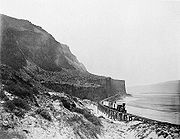
Celilo Falls
Celilo Falls was a tribal fishing area on the Columbia River, just east of the Cascade Mountains, on what is today the border between the U.S. states of Oregon and Washington...
was the Venture, built near the Cascades, with the objective of hauling her around Celilo and putting her to run on the upper river. This never happened, as upon launch, the Venture was swept over the Cascades, and damaged by hitting a rock on the way down. The Colonel Wright, launched October 24, 1858, at the mouth of the Descutes River, was the first steamboat to operate on the upper Columbia. In 1860, the owners of Wright built another boat, the Tenino, at Celilo Falls, which proved to be immensely profitable. Eventually the Oregon Steam Navigation Company built a portage railroad on the south side of the river that ran between The Dalles and Celilo.
Snake River
The Snake RiverSnake River
The Snake is a major river of the greater Pacific Northwest in the United States. At long, it is the largest tributary of the Columbia River, the largest North American river that empties into the Pacific Ocean...
wound through wheat-producing regions of eastern Washington. Farmers in these areas wanted to ship their products out as cheaply as possible, and looked to riverine transport as a way to do it. The problem was there were too many rapids and other obstructions to allow economic use of the river in its natural state. O.S.N.
Oregon Steam Navigation Company
The Oregon Steam Navigation Company was an American company incorporated in 1860 in Washington with partners J. S. Ruckle, Henry Olmstead, and J. O. Van Bergen...
pressured the government to do something about this, and so in 1867, the Corps of Engineers launched a two year survey of the upper Columbia and the Snake River, targeting rapids and other areas for work to improve navigability. During the next few years, rapids and obstructions at various points in both these rivers were removed or meliorated, largely at government expense.
Rise of monopoly power over the river
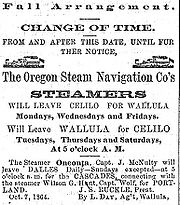
John C. Ainsworth
John Commingers Ainsworth was an American pioneer businessman and steamboat owner in Oregon. A native of Ohio, he moved west to mine gold in California before immigrating to Oregon where he piloted steamships and became a founder of the Oregon Steam Navigation Company and several banks.-Early...
and L.W. Coe formed the Oregon Steam Navigation Company
Oregon Steam Navigation Company
The Oregon Steam Navigation Company was an American company incorporated in 1860 in Washington with partners J. S. Ruckle, Henry Olmstead, and J. O. Van Bergen...
which quickly gained monopoly power over the most of the boats on the Columbia and Snake
Snake River
The Snake is a major river of the greater Pacific Northwest in the United States. At long, it is the largest tributary of the Columbia River, the largest North American river that empties into the Pacific Ocean...
rivers, as well as the portages at the Cascades and from The Dalles to Celilo. The O.S.N. monopoly lasted from about 1860 to 1879, when its owners sold out to the Oregon Railroad and Navigation Company
Oregon Railroad and Navigation Company
The Oregon Railroad and Navigation Company was a railroad that operated a rail network of of track running east from Portland, Oregon, United States to northeastern Oregon, northeastern Washington, and northern Idaho...
("OR&N") and realized an enormous profit.
O.R. & N was an enterprise of Henry Villard
Henry Villard
Henry Villard was an American journalist and financier who was an early president of the Northern Pacific Railway....
and ten partners who raised $6 million in an effort to expand the O.S.N. monopoly to control all rail and steamboat transport in Oregon and the Inland Empire
Inland Empire (Pacific Northwest)
thumb|The Inland Empire regionThe Inland Northwest, or Inland Empire, is a region in the Pacific Northwest centered on Spokane, Washington, including the surrounding Columbia River basin and all of North Idaho....
. Purchase of O.S.N.
Oregon Steam Navigation Company
The Oregon Steam Navigation Company was an American company incorporated in 1860 in Washington with partners J. S. Ruckle, Henry Olmstead, and J. O. Van Bergen...
gave Villard and his allies control over just about every steamboat then operating on the Columbia, including all the OSN boats already mentioned, plus Emma Hayward, S.G. Reed, Fannie Patton, S.T.Church, McMinnville, Ocklahama, E.N. Cook, Governor Grover, Alice, Bonita, Dixie Thompson, Welcome, Spokane, New Tenino, Almota, Willamette Chief, Orient, Occident, Bonanza, Champion, and D.S.Baker.
Railway completion forces steamboats off routes
In April, 1881, O.R.& N. completed railways on the south side of the river from Celilo to Wallula, and, in October 1882, from PortlandPortland, Oregon
Portland is a city located in the Pacific Northwest, near the confluence of the Willamette and Columbia rivers in the U.S. state of Oregon. As of the 2010 Census, it had a population of 583,776, making it the 29th most populous city in the United States...
to The Dalles. This left the middle Columbia expensive to navigate because of the need to surmount two portages on the way upriver. O.R.& N.
Oregon Railroad and Navigation Company
The Oregon Railroad and Navigation Company was a railroad that operated a rail network of of track running east from Portland, Oregon, United States to northeastern Oregon, northeastern Washington, and northern Idaho...
started bringing its boats down to the lower river from the middle and upper stages, with the strategy of forcing patrons to use its railroads rather than its steamboats. Harvest Queen was taken over Celilo Falls in 1881 from the upper to the middle river under the command of captain Troup. Troup brought D.S. Baker over Celilo in 1888. and in 1893, over the Cascades.
Villard, in control of O.R. & N then made one of his biggest mistakes when he brought from the east coast two enormous iron-hulled vessels, Olympian
Olympian (sidewheeler)
The steamship Olympian operated from 1884 to about 1890 on the Columbia River, Puget Sound, and the Inside Passage of British Columbia and Alaska...
and Alaskan
Alaskan (sidewheeler)
The steamship Alaskan operated from 1884 to 1889 on the Columbia River and Puget Sound. Alaskan and her near-sistership Olympian were known as “Henry Villard’s White Elephants.” There were a number of vessels named Alaska and Alaskan, this large side-wheel steamboat should not be confused with...
, and placed them on routes on the Columbia and Puget Sound. The huge size and expense of these vessels precluded them from ever making a profit.
Opposition to O.R.& N. began to arise in 1881 on the lower and middle Columbia. Captain U.B. Scott formed a concern with L.B. Seely and E.W. Creighton to put Fleetwood
Fleetwood (steamboat)
The steamboat Fleetwood operated in the 1880s and 1890s on the Columbia River and later as part of the Puget Sound Mosquito Fleet.-Construction:...
, a propeller boat, on the run up to the Cascades. Gold Dust was hauled over the Cascades
Cascades Rapids
The Cascades Rapids were an area of rapids along North America's Columbia River, between the U.S. states of Washington and Oregon. Through a stretch approximately wide, the river dropped about in .-Boat portage:Boat travelers were forced to either portage boats and supplies or pull boats up with...
to compete on the middle river. This competition lowered fares down to 50 cents from Portland to The Dalles. Another competitor which arose in about 1880 was the Shaver Transportation Company
Shaver Transportation Company
The Shaver Transportation Company is an inland water freight transportation company based in Portland, Oregon, United States. The company was founded in 1880, and played a major role in the development of freight transport in the Portland area and along the Columbia., Harry L...
.
.jpg)
Celilo Falls
Celilo Falls was a tribal fishing area on the Columbia River, just east of the Cascade Mountains, on what is today the border between the U.S. states of Oregon and Washington...
, generally at high water. In 1881, Captain James W. Troup took Harvest Queen from the upper river over Celilo Falls into the middle river. In 1890 Captain Troup took her over the Cascades into the lower river. Troup brought D.S. Baker over Celilo Falls in 1888, and then over the Cascades in 1893.
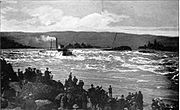
Hassalo (sternwheeler 1880)
The steamboat Hassalo operated from 1880 to 1898 on the Columbia River and Puget Sound. Hassalo became famous for running the Cascades of the Columbia on May 26, 1888 at a speed approaching an hour...
over the Cascades at close to 60 miles (96.6 km) an hour as 3,000 people watched. By 1893, the Oregon Railway and Navigation Company had completed a route all along the south side of the river
Oregon Portage Railroad
The Oregon Portage Railroad was the first railroad in the U.S. state of Oregon. It originally ran for with of telegraph line, and was later extended to a length of...
. As a result, steamboating virtually ended on the Columbia and Snake Rivers above the Dalles, at least until November 1896, when the Cascade Locks and Canal were completed, allowing open river navigation all the way from Portland to The Dalles.
Lock and canal improvements to the river
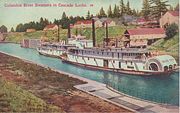
Late steamboat operations
_1901.jpg)
Potlatch, Idaho
Potlatch is a city in Latah County, Idaho, United States. The population was 791 at the 2000 census.-History:Potlatch was founded in 1905 as a company town by the Potlach Corporation. The townsite was chosen because of proximity to Potlatch Corporation's large holdings of western white pine on the...
, the J.M. Hannaford was launched, unusual as she was built in the Mississippi style, with two stacks forward of her pilot house, instead of the single stack aft, as was the design for the vast majority of other Columbia River boats ever since the Jennie Clark. Several boats were rebuilt in 1900, and in 1901, newly constructed vessels included the Charles R. Spencer, an elegant passenger vessel intended for the Portland-The Dalles run, whose whistle was reportedly so powerful it could "make rotten piles totter." Other new vessels included the freighter/towboats F.B. Jones, and M.F. Henderson. As with other years, several vessels were reconstructed.
Last years
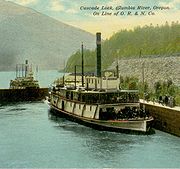
Bailey Gatzert (sternwheeler)
The Bailey Gatzert was a famous sternwheel steamboat that ran on the Columbia River and Puget Sound from the 1890s to the 1920s. She was named after Bailey Gatzert, an early businessman and mayor of Seattle...
and the Dalles City, with the Bailey running excursions and passenger traffic from Portland to The Dalles, and Dalles City running freight and passengers along the same route, but making more stops. Downriver to Astoria, the T.J. Potter had been condemned in 1916, and, with some exceptions, the boats of Harkins Transportation Company
Harkins Transportation Company
Harkins Transportation Company was founded in 1914 by L.P. Hosford, Henry L. Pittock, and A.J. Lewthwaite. The line was named after the tugboat Jessie Harkins, which had been built by Jacob Kamm and named after Hosford's niece. The line ran steamboats on the lower Columbia from 1914 to 1937, when...
, including the new steam propeller Georgiana
Georgiana
Georgiana is an English name. It is the feminine form of the male name George and a variation of the female names Georgina and Georgia. It comes from the Greek word Γεωργιος, meaning farmer.-Places:*Georgiana, Alabama*Georgiana County, New South Wales...
(built 1914), were the only major boats on the river.
Final decline
The Bailey Gatzert excursion runs up the Columbia came to an end in 1917 when the Bailey was transferred to Seattle, Washington, to serve the Seattle-Bremerton route, then much in demand because of wartime marine construction at the Bremerton Navy Yard. Railroad and highway construction in the early 1920s finished off the steamboat trade. By 1923, major passenger and freight steamboat operations on the lower and middle Columbia had ceased, except for towboats, and until 1937, the passenger and freight boats of the Harkins Transportation CompanyHarkins Transportation Company
Harkins Transportation Company was founded in 1914 by L.P. Hosford, Henry L. Pittock, and A.J. Lewthwaite. The line was named after the tugboat Jessie Harkins, which had been built by Jacob Kamm and named after Hosford's niece. The line ran steamboats on the lower Columbia from 1914 to 1937, when...
on the lower Columbia, such as Georgiana. For a brief time, in 1942, the now-famous Puget Sound propeller steamer Virginia V was brought down to the Columbia river, thus becoming (although it was not known at the time) the last survivor of the wooden steamboat fleets of both Puget Sound and of the Columbia River.
Last runs
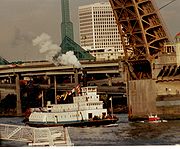
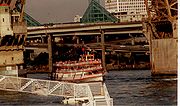
1906 San Francisco earthquake
The San Francisco earthquake of 1906 was a major earthquake that struck San Francisco, California, and the coast of Northern California at 5:12 a.m. on Wednesday, April 18, 1906. The most widely accepted estimate for the magnitude of the earthquake is a moment magnitude of 7.9; however, other...
. Her last commercial run came on March 20, 1947. The trip was described in McCurdy as follows:
Mills, an English professor when he was not writing books on history, used his full talent with the language to capture the occasion:
Georgie Burton was moored up at The Dalles, with the objective of turning her into a museum boat. Unfortunately the great Columbia River flood of 1948 broke her loose from her mooring and wrecked her.
The last steamboat race on the Columbia was held in 1952, between Henderson and the new steel-hulled Portland, both towboats. This was actually more of an exhibition than a race. The famous actor James Stewart
James Stewart (actor)
James Maitland Stewart was an American film and stage actor, known for his distinctive voice and his everyman persona. Over the course of his career, he starred in many films widely considered classics and was nominated for five Academy Awards, winning one in competition and receiving one Lifetime...
and other members of the cast of the recently-filmed movie Bend of the River
Bend of the River
Bend of the River is a 1952 American Western film directed by Anthony Mann and starring James Stewart in their second collaboration. The film is based on the novel Bend of the Snake by Bill Gulick.-Plot:...
were on-board the Henderson. The race was witnessed by Capt. Homer T. Shaver, who stated that as both were running fast for their design, as towboats, the speeds were not much compared to what he'd seen as a young man on the river. Again, the results were summed up by McCurdy:
In 1995, there was a "race" (again, more of an exhibition) between the steam-powered sternwheeler Portland and the diesel-powered excursion sternwheeler Cascade Locks. The vessels picked up their passengers at the seawall in Portland, ran north about to the Fremont Bridge, then "raced" south down the Willamette. The images at left show the boats passing under the lifting spans of the Burnside Bridge.
Wrecks
Boats were lost for many reasons, including striking rocks or logs ("snags"), fire, boiler explosion, or puncture or crushing by ice. Sometimes boats could be salvaged, and sometimes not.Surviving vessels
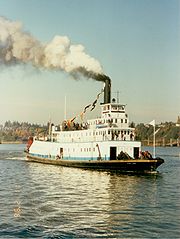
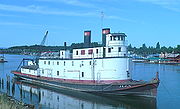
Moyie (sternwheeler)
The Moyie is a paddle steamer sternwheeler that worked on Kootenay Lake in British Columbia, Canada from 1898 until 1957.After her nearly sixty years of service, she was sold to the town of Kaslo and restored...
and Sicamous are the only surviving sternwheelers from before 1915. (No sidewheelers survive.) Neither is operational, and both are kept permanently out of water. They are preserved as museums. These are unique as they are both from the time of passenger carrying steamboats in the Pacific Northwest. Moyie is said to be the oldest surviving vessel of her kind, and this is probably true.
Only one operational sternwheel steamboat survives on the entire Columbia River
Columbia River
The Columbia River is the largest river in the Pacific Northwest region of North America. The river rises in the Rocky Mountains of British Columbia, Canada, flows northwest and then south into the U.S. state of Washington, then turns west to form most of the border between Washington and the state...
system, north or south of the border, and that is the Portland, moored at Portland, Oregon
Portland, Oregon
Portland is a city located in the Pacific Northwest, near the confluence of the Willamette and Columbia rivers in the U.S. state of Oregon. As of the 2010 Census, it had a population of 583,776, making it the 29th most populous city in the United States...
. Unlike Sicamous and Moyie, Portland never carried passengers on a regular basis, but was built as a towboat. The steel-built steam tug Jean is also in Portland, but has been stripped of her paddle wheel and is lying in a semi-derelict state in Columbia Slough
Columbia Slough
The Columbia Slough is a narrow waterway, about long, in the floodplain of the Columbia River in the U.S. state of Oregon. From its source in the Portland suburb of Fairview, the Columbia Slough meanders west through Gresham and Portland to the Willamette River, about from the Willamette's...
.
Another boat, W.T. Preston
WT Preston
The W.T. Preston is a specialized sternwheeler that operated as a snagboat, removing log jams and natural debris that prevented river navigation on several Puget Sound-area rivers. It is now the centerpiece of the Snagboat Heritage Center in Anacortes, Washington. It was designated a National...
, a Corps of Engineers
United States Army Corps of Engineers
The United States Army Corps of Engineers is a federal agency and a major Army command made up of some 38,000 civilian and military personnel, making it the world's largest public engineering, design and construction management agency...
snagboat
Snagboat
A snagboat is a river boat, resembling a barge with superstructure for crew accommodations, and deck-mounted cranes and hoists for removing snags and other obstructions from rivers and other shallow waterways....
, survives as a museum at Anacortes and is reported to be operational. Unlike Portland however, W.T. Preston is not kept in the water. The propeller steamer Virginia V
Virginia V
The steamship Virginia V is the last operational example of a Puget Sound Mosquito Fleet steamer...
which technically may have been the last wooden steamboat in regular commercial passenger service on the Columbia (in 1942) has been restored and is operational in Seattle, Washington.
See also
- Columbia River Maritime MuseumColumbia River Maritime MuseumThe Columbia River Maritime Museum is a museum of maritime history located about ten miles from the mouth of the Columbia River in Astoria, Oregon, U.S.. It has a national reputation for the quality of its exhibits and the scope of its collections and was the first museum in Oregon to meet...
- Historic ferries in OregonHistoric ferries in OregonHistoric ferries in Oregon are water transport ferries that operated in Oregon Country, Oregon Territory, and the state of Oregon, United States...
- Steamboats of the MississippiSteamboats of the MississippiSteamboats played a major role in the 19th Century development of the Mississippi River and its tributaries by allowing the practical large-scale transport of passengers and freight both up- and down-river. Using steam power, riverboats were developed during that time which could navigate in...
Typical craft and uses
- Norma This image shows use of sternwheeler as a tug on the Columbia river, pushing a barge loaded with railcars, combining two transportation modes.
- Harvest Queen acting as tug for sailing vessel, Astoria 1906 As with the image of Norma acting as a tug for a rail car barge upriver, this image shows the versatility of sternwheelers in being able to assist oceangoing ships as well.
- Service, Cowlitz, and Nestor tied up at a dock, sometime in 1920s This shows three typical everyday working steamboats, one, Service, with three decks, and the remaining smaller boats with only two.
- Hattie Bell, at Rooster Rock, lower Columbia River Shows the deep water of the Columbia close to shore by Rooster Rock at the west end of the Columbia Gorge and how close steamboats could run by the shore in this area.
- Northwestern, probably on the Willamette River This photograph shows the narrowness of the Willamette River compared to the Columbia and also the wooden awning over the foredeck common on many Willamette river steamboats.

